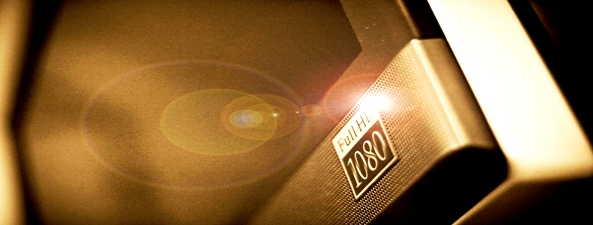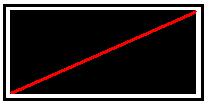If you are in the market for a new flat panel TV, you will be overwhelmed with a lot of brands and models. Finding the right one to fit your needs can be a tough task. The dilemma that Indian customers face is whether to go for Full HD or just HD Ready TV. Since the price difference is substantial, it is important to make an informed decision.
To understand the difference between Full HD and HD Ready TVs, it is important to know some basic display jargon.
Screen size: This is the size of the display measured diagonally. In the image below, the length of the red diagonal line gives the screen size of the TV.
Resolution: The number of distinct pixels in each direction that can be displayed on the screen. More the resolution, better the image quality.
The primary difference between Full HD and HD Ready TVs is resolution. Resolution of a Full HD TV is double of that of a HD Ready TV.
Resolution of Standard Definition (Conventional) TVs is 720 H x 480 V = less than 1 million pixels.
Resolution of HD Ready TVs is 1366 H x 768 V = 1 million pixels
Resolution of Full HD TVs is 1920 H x 1080 V = 2 million pixels.
* H = number of Horizontal pixels, V = number of vertical pixels
The image above (captured from Sony Bravia Website, India), illustrates the difference in SD, HD Ready and Full HD TVs. Clearly, the image quality of Full HD TVs is far better than that of SD and HD Ready TVs.
What are “i”s and “p”s appended at the end of resolutions?
You might have come across TVs capable of displaying 720p, 1080i and 1080p resolutions. The “i” and “p” stand for Interlaced scan and Progressive scan respectively.
Interlaced scan displays each frame by dividing it into odd and even horizontal lines and displaying them consecutively. The switching is too fast for human eye to catch on standard definition TVs. However, in high resolution TVs, it is easily noticeable.
Progressive scan draws all the lines of a frame in one go.

The above image from wikipedia illustrates the difference between interlaced and progressive scan.
To cut a long story short, “p” is always better that “i”.
Verdict: You should always go for a Full HD TV. Even though Full HD broadcast is not yet available in India, it will be in a few years time. Moreover, once Blue Ray and Playstation 3 gain popularity in India, your Full HD TV will be able to play it the way it is meant to be played.
[Home page image courtesy by Jesper Voetmann]







19 responses to “woikr explains: Full HD and HD Ready TVs”
good one. i was looking for this kind of info. Thanks!
As usual , detailed and accurate stuff from Setu sir , gud work sir.
You've made three serious errors. First, SD pictures in India don't have 480 lines, they have 576 lines. That's because India uses PAL, like most of the world, rather than NTSC like the US, Canada and Japan. Second, most people's visual acuity isn't good enough to be able to see the higher resolution of Full HD compared to HD Ready at normal viewing distance of 10 feet (3 metres) unless the screen is more than 50 inches (125cm). Third, SD transmissions (which is what's being broadcast now) have to be upscaled from 576 lines to 768 lines or 1080 lines. Upscaling blurs the image and more upscaling blurs more. So watching SD on a Full HD display actually gives you a worse picture than on an otherwise equivalent HD Ready display. Don't believe everything you read on a Sony website.
@Simon –
Appreciate your feedback.
I accept your premise about the PAL system.
As far as visual acuity is concerned, I am sure if you tell anyone that a Full HD TV is better than a HD ready TV, even if they cannot spot the difference easily, they will be inclined to buy the full HD one. Reason – people do not change TVs frequently. Especially here in India, TVs last for more than 5 years before they are changed. Hence, it is important that they buy the best their money can buy.
Regarding your last point, I agree that the images might get a little blurred when they are upscaled from SD, however, the resulting experience is still far better than a conventional CRT TV. Mainly because LCDs and Plasmas offer much better contrast ratio and refresh rate. The resolution of the picture is not the only factor which determines the overall quality. Additionally, if you use a PAL to VGA converter, the results are much better.
I am recommending Full HD TVs over HD ready ones keeping the future in mind. Blu Ray, PS3 and XBOX are slowly gaining popularity in India. Plus with competition pumping up in the DTH arena, we might see the launch of HD services in India soon. An indication is Tata Sky+.
"I am recommending Full HD TVs over HD ready ones keeping the future in mind. Blu Ray, PS3 and XBOX are slowly gaining popularity in India."
Yes but how many will buy these things? For the general population(people who are ready to spend below 50K) popular thought is still HD ready. Sun Direct charges Rs 100 per HD channel.!!! maybe in the future prices will come down and there will be more hd content available…. but I think its in the distant future.
Anyways nice article…..
Nice Article, Except for the last part. We won't have Full HD bradcasts or Full HD signals in India, or anywhere else in the world for a long time. Even now very few select channels provide this. It will take atleast 3-4 years for HD ready level broadcasts in India much less Full HD. Blu Ray is also too expensive right now.
Go in for a HD ready TV now at half the price, in 4 years time even the Full HD TVs will be obsolete and at a 1/3 todays rates (factoring in the inflation of course), might make more sense to just take the HD ready TVs now as the resolution is much more than anything we can throw at them for the next few years anyway, The rest is a marketing gimmick and tech crazy reviewers who think that everyone just uses TVs for Blu Ray discs or PS3s. Not a sensible buy either way.
Thanx for ton of informatioon.
How do u rate FW 13 when compared with MacBook Pro 15 inches or 17 inches, more when I have to use it for photos / movies, clicked on Sony AVCHD mode?
Please guide. Thanx.
Waiting for ur remarks.
Definitely Macbook Pro. With it's super awesome screen, you will be able to enjoy your photos and movies in the best possible way!
Thanx a lot. My choice is now final.
Bye.
thanks dude..nice work..
[…] transmissions offer 5 times more pixels than SD transmission. HD ready transmission at 720p or 1080i are substantially superior to their SD counterparts as they […]
[…] in India (Dish TV, Reliance Big TV, Airtel Digital TV and Tata Sky) are planning to launch High Definition (HD) set top boxes (STB) this year. Sun DTH already has HD ready boxes and HD service in […]
[…] are probably up-scaled from their SD content. So their quality might appear slightly lower than the actual HD channels (Nat Geo HD and Discovery […]
Detailed and well explained with the help of pictures.
Very nice explanation from you. Lets expect in Indian almost all our favourite indian channels will switch to HD platform. !!
Very useful and simply explained.
Thanks
I think i should be fairly confident of shopping for one with you now…Nicely explained…
is there a good full hd ready ,non dell xps 15/16 laptop for upto 50 k ?
dell takes ages to deliver the bloody thing .
i’d look at lenovo and hp for competitive pricing
There is nothing like “Full HD ready” 🙂
Dell makes both HD Ready and Full HD XPS laptops. Not sure about the price though.